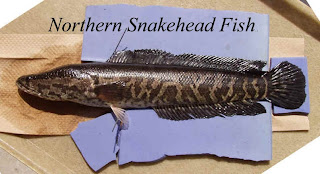
They have become notorious as an invasive species.

Snakeheads can become invasive species and cause ecological damage because they are top-level predators, meaning they have no natural enemies outside of their native environment. Not only can they breathe atmospheric air, but they can also survive on land for up to four days, provided they are wet, and are known to migrate up to 1/4 mile on wet land to other bodies of water by wriggling with their body and fins. National Geographic has referred to snakeheads as "Fishzilla" and the National Geographic Channel reports that the "northern snakehead reaches sexual maturity by age 2 or 3. Each spawning-age female can release up to 15,000 eggs at once. Snakeheads can mate as often as five times a year. This means in just two years, a single female can release up to 150,000 eggs."
Since 2002 it has been illegal to possess a live snakehead in many U.S. states, where they are considered a destructive invasive species.
Snakeheads are considered valuable food fish. Called nga gyi in Burmese, it is a prized fish eaten in a variety of ways. In Vietnam, they are called ca loc, ca qua, or ca chuoi, it is prized in clay pot dishes and pickled preparations. Larger species, such as Channa striata, Channa maculata, and Parachanna obscura, are farmed in aquaculture. In the United States, chefs have suggested controlling the snakehead invasion by serving them in restaurants.
